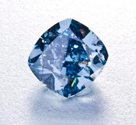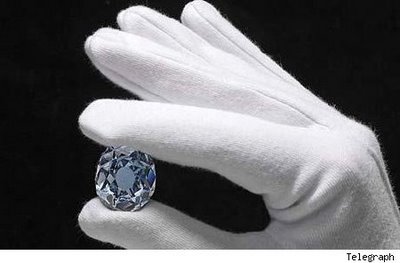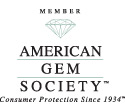What is a Fancy Blue Diamond?
April 23rd, 2009 by James L. Sweaney, CGA, FGA. GG
from Rapaport
The recent buzz about the 7.03 carat Cullinan Blue diamond to be offered at the upcoming Sotheby’s auction in Geneva has generated a lot of interest in colored diamonds. Because there is a lot of misinformation about these ultra-rare gems, we thought it would be helpful to our readers to describe and discuss some of the characteristics of Fancy Blue diamonds.
Most diamonds occur in a group known as the Cape series, where the color grades range from D (colorless) to Z (yellow). This name refers to the Cape of Good Hope and the early days of diamond mining in South Africa.
The majority of all diamonds are Type I, broadly defined as diamonds containing impurities of nitrogen. Nitrogen is the cause of the yellowish tint in diamonds of the Cape series. The Type I category is further divided into Type I a–diamonds with nitrogen in platelets within the crystal structure and Type I b– diamonds containing dispersed nitrogen. Type I b occurs in only .1 % of Type I.
Type II a diamonds contain no significant nitrogen and are about 1-2% of all natural diamonds. Type II b diamonds contain small amounts of aluminum and boron, and make up only 0.1% of all diamonds. All natural blue diamonds are type II b. Type II b diamonds may be easily distinguished from all other types—because of the boron impurity, they conduct electricity. A simple conductivity test used in gemological labs proves a diamond to be type II b or not.
Type III diamonds are those of meteoric origin having hexagonal structure (all other types have a cubic structure). See our Blog about hexagonal diamonds and comet fall
Since most diamonds are Type I a, the normal color range for diamond is colorless to yellow, with minor variations with that range. These diamonds are normally graded with a color grade based on the GIA system, where letters D thru Z designate the grades. At letter grade Z, the gem would be graded “Fancy Yellow”
The term Fancy is a grading term used in conjunction with a particular color name such as Blue, Pink, Yellow as in “Fancy Blue”, etc. Fancy is not actually a grade in the sense of a calibrated grading scale like we have for the Cape series, but rather a descriptive term that is only applied to natural color diamonds where the color is both attractive and/or rare.
By definition, Fancy defines the color of the diamond as being natural and the diamond as being natural. Fancy is never used to describe or designate diamonds with treated color developed by the various treatments and technologies. The blue diamonds commonly seen on various Internet marketing sites are treated by irradiation and heating—the price alone tells the tale.
Modifiers are added to the color name to make the description more like the perceived color. Some modifiers are positive, meaning they add to the desirability, uniqueness, and/or rarity of the stone, as in Violet Blue or Purplish Pink or Orangy Yellow. Other modifiers, such as “grayish” or “brownish” usually diminish the value of the stone, because the color is less saturated.
In addition, modifiers are added to the color description to designate the level of color. Most natural colors in diamond never reach the levels of saturation we see in colored stones, and are in many cases what we might call a pastel or tint. Accordingly, these color level designations are crucial to the value and desirability of the colored diamond. In the case of a blue diamond, these modifiers would be, in order of impact on value, lowest to highest, Fancy Very Light Blue, Fancy Light Blue, Fancy Blue, Fancy Intense Blue, and Fancy Vivid Blue.
Famous Fancy Blue diamonds include the 35.56 ct. Wittelsbach Blue, an interesting historic but not especially beautiful stone, which sold in December 2008 for a record high price for any diamond, $24.3 million,

the Heart of Eternity, the largest Fancy Vivid Blue diamond at 27.64, sold sometime in 2000, estimated value $16 million, and of course, the famous Hope diamond, residing at the Smithsonian.
Interestingly, the only diamond mine known for an appreciable production of blue diamonds is the Premier Diamond Mine of South Africa. In addition to the 7 ct. Cullinan Blue and the 27 ct. Heart of Eternity, the Premier is famous for producing another historic diamond, the Cullinan, the largest diamond ever found at 3,106.75 carats.
Thus, we can see that the 7 ct Cullinan Blue, graded Internally Flawless Fancy Vivid Blue, is an extremely rare type of diamond, an extremely rare size, an extremely rare clarity, and an extremely rare color. That’s why whoever buys it may be willing to shell out $1000,000 per carat. Truly, a connoisseur’s stone.
A final note—many type I diamonds fluoresce a blue color to varying degrees in the presence of ultraviolet light. When the stone is near colorless or better, a strong blue fluorescence can give the diamond a bluish overtone that used to be called “blue-white”. A strongly flourescent white diamond might have a somewhat similar appearance to a Fancy Very Light Blue diamond in some lighting environments, but the phenomenon is entirely different and much more common than what we see in type IIb dianmonds. The term “blue-white” is no longer used; because of the possible confusion with natural color blue diamonds, the Federal Trade Commission proscribes it.
Those who are looking for a great gem investment and who have a deep pocket would do well to consider a natural blue diamond– these beautiful gems are so rare that demand consistently pushes prices ever higher, even in this difficult economy. Today, eye clean one carat Fancy Blue diamonds start around $100,000 per carat (if you can find one) — when I was a gemologist at GIA in the late 70’s, they sold for about $5,000 per carat. That’s a twenty fold appreciation in 40 years! Call for information about our gem brokering service!
Tags: cullinan, fancy blue diamond, Hope Diamond, natural blue diamond, Premier Mine, type IIb, Wittelsbach Blue







